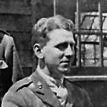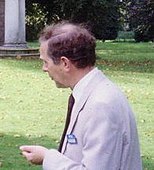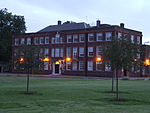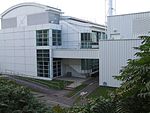National Physical Laboratory (United Kingdom)

NPL’s main entrance on Hampton Road
|
|
| Established | 1900 |
|---|---|
| Research type | Applied Physics |
| Budget | £3 million[1] |
|
Field of research
|
Metrology |
| Director | Peter Thompson |
| Staff | 750 |
| Address | Hampton Road, Teddington, TW11 0LW, England |
| Location | 51°25′35″N 0°20′37″WCoordinates: 51°25′35″N 0°20′37″W |
|
Operating agency
|
Department for Business, Energy and Industrial Strategy |
| Website | npl |
The National Physical Laboratory (NPL) is the national measurement standards laboratory for the United Kingdom. Founded in 1900, it is one of the oldest standardising laboratories in the world.
Today, it is one of the most extensive government laboratories in the UK and has a “prestigious” reputation for its role in setting and maintaining physical standards for British industry. The heads of the NPL have included many individuals who were pillars of the British scientific establishment.[2][3] Research work at NPL has contributed to the advancement of many disciplines of science, including the development of atomic clocks as well as packet switching, which is today one of the fundamental technologies of the Internet.[4][5][6]
NPL is based at Bushy Park in Teddington, England. It comes under the management of the Department for Business, Energy and Industrial Strategy.
History[edit]
The National Physical Laboratory was established in 1900 at Bushy House “to bring scientific knowledge to bear practically upon our everyday industrial and commercial life”.[7] It grew to fill a large selection of buildings on the Teddington site.[8] NPL procured a large state-of-the-art laboratory under a Private Finance Initiative contract in 1998. The construction, which was being undertaken by John Laing, and the maintenance of this new building, which was being undertaken by Serco, was transferred back to the DTI in 2004 after the private sector companies involved made losses of over £100m.[9]
The laboratory was initially run by the UK government, with members of staff being part of the civil service. Administration of NPL was contracted out in 1995 under a Government Owned Contractor Operated model, with Serco winning the bid and all staff transferred to their employ. Under this regime, overhead costs halved, third party revenues grew by 16% per annum, and the number of peer-reviewed research papers published doubled.[10] It was decided in 2012 to change the operating model for NPL from 2014 onward to include academic partners and to establish a postgraduate teaching institute on site.[11] The date of the changeover was later postponed for up to a year.[12] The candidates for lead academic partner were the Universities of Edinburgh, Southampton, Strathclyde and Surrey[13] with an alliance of the Universities of Strathclyde and Surrey chosen as preferred partners.[14]
In January 2013 funding for a new £25m Advanced Metrology Laboratory was announced that will be built on the footprint of an existing unused building.[15][16]
The operation of the laboratory transferred back to the Department for Business, Innovation and Skills (now the Department for Business, Energy and Industrial Strategy) ownership on 1 January 2015.[17]
Notable researchers[edit]
Researchers who have worked at NPL include:[18] D. W. Dye who did important work in developing the technology of quartz clocks. The inventor Sir Barnes Wallis did early development work there on the “Bouncing Bomb” used in the “Dam Busters” wartime raids.[19] H.J. Gough, one of the pioneers of research into metal fatigue, worked at NPL for 19 years from 1914 to 1938. Sydney Goldstein and Sir James Lighthill worked in NPL’s aerodynamics division during World War II researching boundary layer theory and supersonic aerodynamics respectively.[20]
Alan Turing, known for his work at the Government Code and Cypher School (GC&CS) at Bletchley Park during the Second World War to decipher German encrypted messages, worked at the National Physical Laboratory from 1945 to 1947.[21] He designed there the ACE (Automatic Computing Engine), which was one of the first designs for a stored-program computer. Dr Clifford Hodge also worked there and was engaged in research on semiconductors. Others who have spent time at NPL include Robert Watson-Watt, generally considered the inventor of radar, Oswald Kubaschewski, the father of computational materials thermodynamics and the numerical analyst James Wilkinson.[22]
Research[edit]
NPL research has contributed to physical science, materials science, computing, and bioscience. Applications have been found in ship design, aircraft development, radar, computer networking, and global positioning.[23]
Atomic clocks[edit]
The first accurate atomic clock, a caesium standard based on a certain transition of the caesium-133 atom, was built by Louis Essen and Jack Parry in 1955 at NPL.[24][25] Calibration of the caesium standard atomic clock was carried out by the use of the astronomical time scale ephemeris time (ET).[26] This led to the internationally agreed definition of the latest SI second being based on atomic time.[27]
Computing[edit]
NPL has undertaken computer research since the mid-1940s.[28] From 1945, Alan Turing led the design of the Automatic Computing Engine (ACE) computer. The ACE project was overambitious and floundered, leading to Turing’s departure.[29] Donald Davies took the project over and concentrated on delivering the less ambitious Pilot ACE computer, which first worked in May 1950. Among those who worked on the project was American computer pioneer Harry Huskey. A commercial spin-off, DEUCE was manufactured by English Electric Computers and became one of the best-selling machines of the 1950s.[29]
Metrology[edit]
The National Physical Laboratory is involved with new developments in metrology, such as researching metrology for, and standardising, nanotechnology.[30] It is mainly based at the Teddington site, but also has a site in Huddersfield for dimensional metrology[31] and an underwater acoustics facility at Wraysbury Reservoir.[32]
Packet switching[edit]
Beginning in the mid-1960s, Donald Davies and his team at the NPL pioneered packet switching, now the dominant basis for data communications in computer networks worldwide. Davies designed and proposed a national data network based on packet switching in his 1965 Proposal for the Development of a National Communications Service for On-line Data Processing.[33] Subsequently, the NPL team (Davies, Derek Barber, Roger Scantlebury, Peter Wilkinson, Keith Bartlett, and Brian Aldous)[34] developed the concept into a local area network which operated from 1969 to 1986, and carried out work to analyse and simulate the performance of packet-switched networks, including datagram networks. Their research and practice influenced the ARPANET in the United States, the forerunner of the Internet, and other researchers in the UK and Europe.[35][36][37][38]
NPL was also involved in internetworking research. Davies, Scantlebury and Barber were members of the International Networking Working Group (INWG) which developed a protocol for internetworking.[39][40][41] Connecting existing networks creates a “basic dilemma” since a common host protocol would require restructuring the existing networks. NPL connected with the European Informatics Network (Barber directed the project and Scantlebury led the UK technical contribution)[42][43][44] by translating between two different host protocols; that is, using a gateway. Concurrently, the NPL connection to the Post Office Experimental Packet Switched Service used a common host protocol in both networks. NPL research confirmed establishing a common host protocol would be more reliable and efficient.[45] The EIN protocol helped to launch the proposed INWG standard.[46]
NPL sponsors a gallery, opened in 2009, about the development of packet switching and “Technology of the Internet” at The National Museum of Computing.[47]
Directors of NPL[edit]
Directors of NPL include a number of notable individuals.[48]
- Sir Richard Tetley Glazebrook, 1900–1919
- Sir Joseph Ernest Petavel, 1919–1936
- Sir Frank Edward Smith, 1936–1937 (acting)
- Lawrence Bragg, 1937–1938
- Sir Charles Galton Darwin, 1938–1949
- Sir Edward Victor Appleton, 1941 (acting)
- Sir Edward Crisp Bullard, 1948–1955
- Dr Reginald Leslie Smith-Rose, 1955–1956 (acting)
- Sir Gordon Brims Black McIvor Sutherland, 1956–1964
- Dr John Vernon Dunworth, 1964–1977
- Dr Paul Dean, 1977–1990
- Dr Peter Clapham, 1990–1995
Managing Directors
- Dr John Rae, 1995–2000
- Dr Bob McGuiness, 2000–2005
- Steve McQuillan, 2005–2008
- Dr Martyn Sené, 2008–2009, 2015 (acting)
- Dr Brian Bowsher, 2009–2015
Chief Executive Officers
- Dr Peter Thompson, 2015–present[49]
NPL buildings[edit]
- NPL buildings













